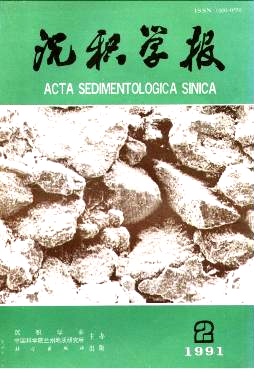Sedimentation and Organic Geochemistry of Source Rocks in the Deep and Shallow-Water Saline Lakes in Tertiary, China
- Received Date: 1989-01-05
- Publish Date: 1991-06-10
Abstract: Dongpu Depression was one of the rifts in eastern China which accumulated sequences of salts and oil source rocks over 2, 000m in thickness during the Oligocene.Every sequence consists of lots of rhythms of 1 -5m thick which comprises light yellow transparent halite and grey-black mudstone interbedded with white laminated gypsum or brown oil shale. A model of deep-water saline lake is given in which the salts and the dark mudstones are deposited at the same time. Mudstones rich in organic matter were proved to be significant source rocks for oil and gas. It is important for the source rocks to deposit that the deep-water saline lake was layered by salinities: the upper part is brackish and aerobic, suitable for organisms living; in contrast the lower one is bitter and anoxic-the best environment for organic matter accumulation and preservation.The Corgof the mudstones deposited in the deep-water saline lake is over 1% and up to 4.4%. The middle and lower parts of Jidic Formation (Miocene) in narthern Tarim Basin, is consist of grey-green mudstones, brown siltstones and shell-shaped gypsums and dispersed granular halites.The sediments were probably formed in a movible shallow saline and aerobic lake, i.e.playa.Corgis only 0.3-0.7% in mudstone, but the interbedded sandstone has intensive showing of oil which implied that the the mudstone is the potential source rock. It was discovered that organic matter in the deep-water saline lake facies comprises a series of 17β 21β hopanes, and the corresponding shallow-one contains 17 (21) hopenes, which indicates that the reduction in sediments of the deep-water saline lake is stronger than that of the shallow one. Bitumen ratio (chloroform extracts / organic carbon) of the immature source rocks of the deep-water salt lake facies in Dongpu Depression is about 7% which is higher than the normal ones, the contents of total hydrocarbon are about 500 ppm.This may be due to the seal ability of the halites to keep the liquid hydrocarbons from leakage. But the bitumen ratio and the content of total hydrocarbon are only 3.37% and 100.93 ppm respectively in the potential source rocks of playa facies of Jidic Formation in Tarim Basin.It can be explained as the bad preservation in the playa sequences. In conclusion, the source rocks of the deep-water saline lake facies are rich in organic matter and able to generate great amounts of oil and gas, and those of the shallow-water saline lake facies have certain potential in hydrocarbon generation.
| Citation: | Jin Qiang. Sedimentation and Organic Geochemistry of Source Rocks in the Deep and Shallow-Water Saline Lakes in Tertiary, China[J]. Acta Sedimentologica Sinica, 1991, 9(2): 114-120. |






 DownLoad:
DownLoad: